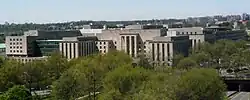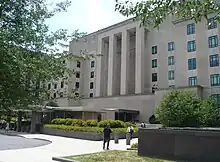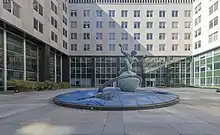Harry S Truman Building
The Harry S Truman Building is the headquarters of the United States Department of State. It is located in Washington, D.C., and houses the office of the United States secretary of state.[3]
| Harry S Truman Building | |
|---|---|
 The Harry S Truman Building in 2008 | |
| Former names | Main State Building |
| Alternative names | State Department building |
| General information | |
| Architectural style | Modern Movement Stripped classical[1] |
| Location | 2201 C Street, NW Washington, D.C. United States |
| Coordinates | 38.8944°N 77.0484°W |
| Current tenants | U.S. State Department |
| Construction started | 1939 |
| Completed | 1941 |
| Renovated | 1960s, 2000s |
| Owner | U.S. federal government |
| Technical details | |
| Size | 53 acres (210,000 m2) [2] |
| Floor area | 1,400,000 square feet (130,000 m2) |
| Design and construction | |
| Architect(s) | Louis A. Simon[1] |
| Other designers | William Dewey Foster Gilbert Stanley Underwood[1] |
The Truman Building is located in the Foggy Bottom neighborhood at 2201 C Street NW, bounded by C Street to the south, E Street, D Street, and Virginia Avenue to the north, 21st Street to the east, and 23rd Street to the west. It is located to the west of Edward J. Kelly Park and north of the National Academy of Sciences building and the National Mall. The Truman Building is named in honor of Harry Truman, the thirty-third president of the United States.
History
Twentieth century
During the early 1930s, the National Capital Park and Planning Commission sought to develop the section of the District of Columbia known as Foggy Bottom, located between C, E, Eighteenth, and Twenty-third streets. Leading up to World War II, the expanding Department of War occupied several different buildings on the mall, making the need for a new building to consolidate operations a high priority. It was always intended to construct the building in two phases, and the Foggy Bottom site was chosen because it was large enough to accommodate both.
Gilbert Stanley Underwood and William Dewey Foster won the contract for the War Department building. They designed the building during 1938–1939 and construction began in 1940. The Public Buildings Administration of the Federal Works Agency, which inherited oversight responsibility for the federal buildings program from the U.S. Treasury Department in 1939, completed the first phase of the building in 1941.[4]
During the design process, several agencies expressed concern that the War Department had already expanded beyond the capacity of the building. These concerns turned out to be correct; while some offices of the War Department moved into the building for a few years, the building never became the War Department headquarters. By the time construction was complete, the War Department had already outgrown the building. Congress appropriated funds for construction of the Pentagon early in 1941, the same year the first phase of the building was completed. Instead, the structure was used for the Department of State. Although the original portion of the building is still commonly referred to as the War Department Building, it became home to the State Department by the late 1940s.
Expansion
World War II spurred the growth of this department as well. However, the planned expansion was delayed until Congress allocated funds for the addition in 1955. Harley, Probst Associates, a joint venture between Harley, Ellington, and Day of Detroit and Graham, Anderson, Probst, and White of Chicago, won the contract for the design in 1956. The addition, known as the State Department Extension, was completed in 1960 and dedicated in 1961. The original building was informally called "Old State" with the addition identified as "New State".
Twenty-first century

In September 2000, the State Department building (previously known as "Main State," and often called by the metonym "Foggy Bottom") was named in honor of President Harry S. Truman.[5]
As of 2007, more than eight thousand employees worked in the Truman Building.[6] The building houses 1.4 million square feet (130,000 m2) to 1.507 million square feet (140,000 m2) of usable space,[7][8] the corridors take up over 267,000 square feet (24,800 m2), and the roof area is about seven acres (28,000 square meters). There are forty-four elevators, over four thousand windows, and about 34,000 fluorescent light fixtures that provide interior illumination.
The building is currently being renovated under a twelve-year plan to modernize the structure.[4] In May 2014, the General Services Administration (GSA) awarded a $25 million contract to build a new public entrance on the east side of the Truman Building. The glass and steel structure acts not only as a high-security entrance to the building but also as a museum about American diplomacy. The 20,000-square-foot (1,900 m2) addition, called the U.S. Diplomacy Center, was designed by the firm Beyer Blinder Belle and constructed by Gilbane Construction. The addition was privately funded by the Diplomacy Center Foundation, a nonprofit established by former secretary of state Madeleine Albright in 2000 to honor American diplomats. The National Capital Planning Commission approved the design in 2011. Construction was completed in 2017. GSA awarded a $77.4 million contract in September 2014 to renovate much of the rest of the structure. Some of the renovations would restructure the interior layout of the building to meet the State Department's needs. However, most of the contract would focus on replacing the building's electrical, elevator, mechanical, plumbing, and telecommunication systems. The refurbishment was scheduled to begin in January 2015 and take 14 months to complete.[9]
The building was listed on the National Register of Historic Places in 2017.
Architecture
The original portion of the building, known as the War Department Building, is an example of the Stripped Classical architectural style with Art Moderne elements. The steel-framed building is clad in limestone and rises eight stories above the basement and sub-basement. Because it was designed to be expanded at a later date, it was deliberately asymmetrical. A central spine connects a U-shaped configuration to the east with an E-shaped configuration to the west.
The east entrance is inspired by the main building of the Sapienza University of Rome campus, designed by italian architect Marcello Piacentini and completed in 1935.
The horizontal delineations of the facade reflect the classical precedents of the architectural style. Cornices and pink granite string courses create a base-shaft-capital system. The wings create a series of interior courtyards. The interior courtyard walls are clad in dark granite, emphasizing the transition from base to shaft.
The construction of the State Department Extension, completed in 1960, is reinforced concrete and was designed in the International style. Buff colored limestone cladding helps to create a cohesive combination of the two buildings. With the completion of the extension, the building became second to the Pentagon in the number of offices that it houses. Since its completion, access to the main ceremonial entrance and lobby is via the south elevation. The entrance is located off-center toward the west end of the building and is set back to frame a forecourt. The court is paved with a combination of gray and red granite. At either side of the forecourt, a limestone belt course runs the full width of the elevation above the basement and second stories. Limestone piers span the first and second stories.

The East Lobby of the original building is a two-story rectangular space surrounded by a screen of paired piers. Four large pendant lights, which are original, are the primary light source. The floors are terrazzo and the walls are travertine. Above the security barriers at the rear of the lobby is a mural by Kindred McLeary titled The Defense of Human Freedoms, which depicts the five freedoms flanked at either end of the mural by their defenders, the American military. Access to the auditorium is via the second floor. The Dean Acheson Auditorium extends upward from the first through the third stories. The stage spans the full east wall of the room. The walls on either side are clad in burled California redwood paneling. The Loy Henderson Conference Room is two stories tall. The walls are Verde Antique marble with brass and bronze accents. A speakers' platform, stepped up at the center, is set along the west wall.
In the lobby of the fifth floor executive office suite is a mural by James McCreery entitled Liberty or Death: Don't Tread on Me. The work is an allegory of the American Revolution, including maps, cannon and other armament, and flags of the era. The eastern section of the fifth floor contains executive office suites for department heads and their staffs. The west side of the corridor includes staff offices and the general council room. The east side of the corridor includes office suites originally designated for the secretary of war and chief of staff.

The south courtyard of the State Department Building features a sculpture by Marshall Fredericks titled The Expanding Universe, which includes a circular fountain and an architectural bronze statue. A treaty room and the ceremonial office of the secretary of state is on the seventh floor. Diplomatic reception rooms were installed on the eighth floor during the 1980s as reproductions of early American architecture. They are furnished with eighteenth-century antique furnishings and eighteenth- and nineteenth-century artwork.
See also
References
- "District of Columbia – Inventory of Historic Sites" (PDF). District of Columbia: Office of Planning. Government of the District of Columbia. September 1, 2004. Archived from the original (PDF) on June 18, 2009. Retrieved August 8, 2009.
- "Harry S Truman State Office Building" (PDF). Retrieved 2020-10-12.
- "Hillary Rodham Clinton – Biography". United States Department of State. state.gov. Archived from the original on January 29, 2009. Retrieved August 8, 2009.
- "Renovated State Department 'world class' space". Congressional and Public Affairs Office, GSA, National Capital Region, Public Buildings Service. Washington Business Journal. 2003-09-12. Retrieved 2008-10-19.
- "State Department headquarters named for Harry S. Truman". CNN.com. Associated Press. September 22, 2000. Archived from the original on December 8, 2004. Retrieved August 8, 2009.
- "Audit of Emergency Preparedness at the Washington Metropolitan Facilities of the Department of State" (PDF). 2007. Retrieved 29 December 2021.
- "Harry S. Truman Building". Retrieved 29 December 2021.
- Alexander, David (2008). The Building: A Biography of the Pentagon. p. 25. ISBN 978-0-7603-2087-7.
By contrast, the War Department Building's successor, the Truman Building, only achieved a surface area of 1.4 million square feet with its new additions of the early 1960s.
- Sernovitz, Daniel J. (October 10, 2014). "State Department's Truman Building to Get Multimillion-Dollar Makeover". Washington Business Journal. Retrieved October 10, 2014.
- Some
 This article incorporates public domain material from websites or documents of the General Services Administration.
This article incorporates public domain material from websites or documents of the General Services Administration.

.jpg.webp)
